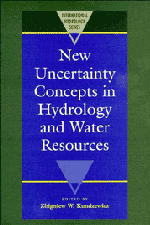Book contents
- Frontmatter
- Contents
- List of Authors
- Preface
- I INTRODUCTION
- II FACETS OF UNCERTAINTY
- III NOVEL APPROACHES TO UNCERTAINTY: FRACTALS, FUZZY SETS AND PATTERN RECOGNITION, NON-PARAMETRIC METHODS
- IV RANDOM FIELDS
- V TIME SERIES AND STOCHASTIC PROCESSES
- 1 Prediction uncertainty in seasonal partial duration series
- 2 A daily streamflow model based on a jump-diffusion process
- 3 The influence of time discretization on inferred stochastic properties of point rainfall
- 4 The distribution of the l-day total precipitation amount
- 5 Analysis of outliers in Norwegian flood data
- 6 Stochastic modelling of the operation of hydrants in an irrigation network
- 7 Order and disorder in hydroclimatological processes
- 8 Towards the physical structure of river flow stochastic process
- VI RISK, RELIABILITY AND RELATED CRITERIA
1 - Prediction uncertainty in seasonal partial duration series
Published online by Cambridge University Press: 07 May 2010
- Frontmatter
- Contents
- List of Authors
- Preface
- I INTRODUCTION
- II FACETS OF UNCERTAINTY
- III NOVEL APPROACHES TO UNCERTAINTY: FRACTALS, FUZZY SETS AND PATTERN RECOGNITION, NON-PARAMETRIC METHODS
- IV RANDOM FIELDS
- V TIME SERIES AND STOCHASTIC PROCESSES
- 1 Prediction uncertainty in seasonal partial duration series
- 2 A daily streamflow model based on a jump-diffusion process
- 3 The influence of time discretization on inferred stochastic properties of point rainfall
- 4 The distribution of the l-day total precipitation amount
- 5 Analysis of outliers in Norwegian flood data
- 6 Stochastic modelling of the operation of hydrants in an irrigation network
- 7 Order and disorder in hydroclimatological processes
- 8 Towards the physical structure of river flow stochastic process
- VI RISK, RELIABILITY AND RELATED CRITERIA
Summary
ABSTRACT In order to obtain a good description of the exceedances in a partial duration series it is often necessary to divide the year into a number (2–4) of seasons. Hereby a stationary exceedance distribution can be maintained within each season. This type of seasonal model may, however, not be suitable for prediction purposes due to the large number of parameters required. In the particular case with exponentially distributed exceedances and Poissonian occurrence times the precision of the T-year event estimator has been thoroughly examined considering both seasonal and non-seasonal models. The two-seasonal probability density function of the T-year event estimator has been deduced and used in the assessment of the precision of approximate moments. The non-seasonal approach covered both a total omission of seasonality by pooling data from different flood seasons and a discarding of nonsignificant season(s) before the analysis of extremes. Mean square error approximations (bias second order, variance first and second order) were employed as measures for prediction uncertainty. It was found that optimal estimates can usually be obtained with a non-seasonal approach.
INTRODUCTION
Since its introduction into flood frequency analysis, the partial duration series (PDS) method has gained increased acceptance as an appealing alternative to the annual maximum series (AMS) method. PDS models were introduced in hydrology by Shane & Lynn (1964), and Todorovic & Zelenhasic (1970). They assumed independent and identically distributed exceedances occurring according to a Poisson process with time-dependent intensity.
- Type
- Chapter
- Information
- New Uncertainty Concepts in Hydrology and Water Resources , pp. 217 - 224Publisher: Cambridge University PressPrint publication year: 1995



